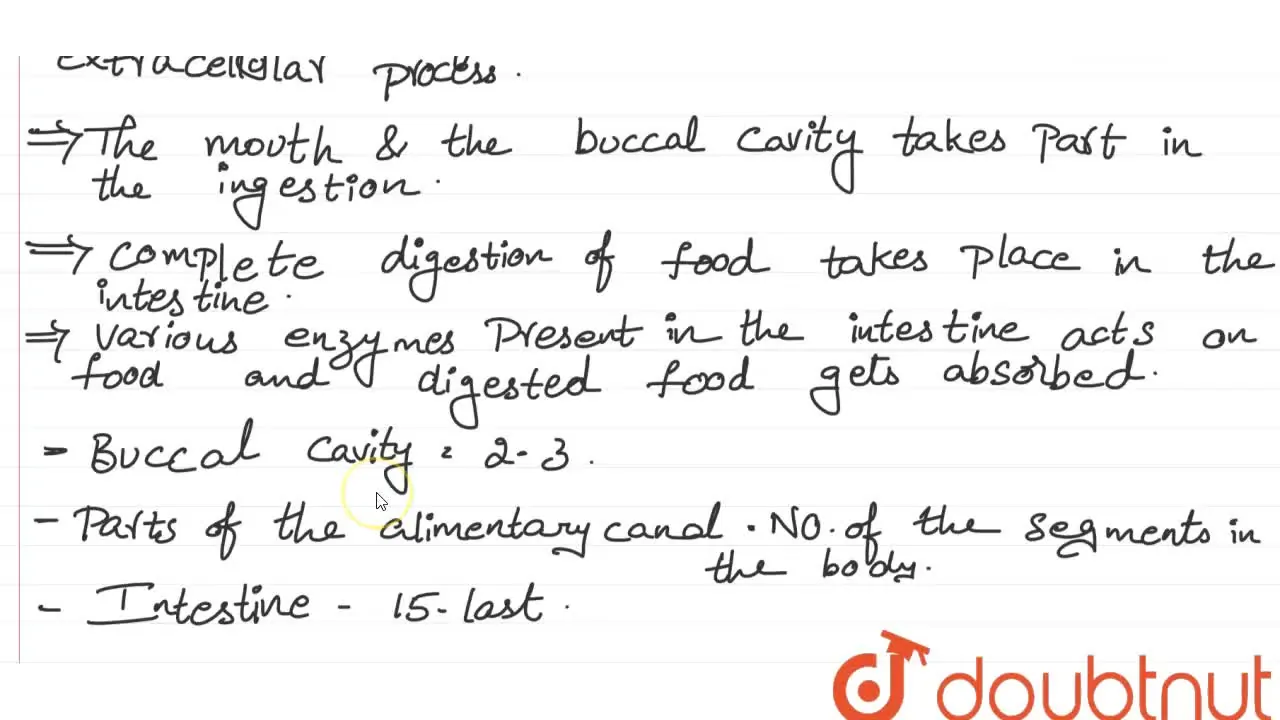Describe the digestive system and process of digestion in pheretima.Solution in Telugu
Digestive system in pheretima : The alimentary canal is a straight tube and runs from the first to the last segment of the body. The mouth opens into the buccal cavity (1-3 segments) which leads into the muscular pharynx (4th segment). A small narrow tube, oesophagus (5-7 segments), continues into a muscular gizzard (8th segment). It helps in grinding the small particles of food the decaying leaves (grinding mill). The stomach extends from the segments 9 to 14. The food of earthworm is decaying. leaves and other organic matter mixed with the soil. Calciferous glands, present in the stomach, neutralise the humic acid present in the humus of the soil. The intestine starts from the 15th segment and continues till the last segment. A pair of short and conical intestinal caecae project from the intestine in the 26th segment. An internal median fold of the dorsal wall of the intestine called typhiosole, helping in increasing the area of absorption, is poorly developed in Pheretima (between the 26th and the rectum which occupies the last 23 to 28 segments). The alimentary canal opens to the exterior by a small rounded aperture called anus. The ingested soil rich in organic matter passes through the digestive tract where digestive enzymes breakdown complex food into smaller absorbable units. These simpler molecules are absorbed through intestinal membranes and are utilised for various metabolic activities.
Process of digestion : Digestion in earthworm is extracellular. Earthworm obtains its nourishment from the organic debris (detrius) present in the soil. So it is called a detritrivore. Pharynx is ejected due to the inside out of the buccal chamber. Pharynx, with the help of its radial· dilator muscles, works as a suction pump in feeding:
The organic food along with the swallowed soil particles is sucked into the pharynx, where it mixes with the salivary secretion. The mucin in the saliva lubricates the gut wall for the easy passage of food and also helps in the formation of bolus. The proteolytic enzyme in the saliva partly digests the proteins. Then the food reaches the gizzard. Its circular muscle and the thick cuticle grind the food Into fine particles. In this state, the food is easily acted upon by the digestive enzymes in the stomach and intestine. The intestinal juice of an earthworm is comparable to the pancreatic juice of the higher animals. All these enzymes like proteases, amylases and lipases act upon the finely ground food and digest the organic matter in it. Proteases digest proteins into amino acids, amylases digest carbohýdrates into glucose and lipases digest lipids into fatty acids and glycerol.
The digested food is absorbed. by the intestinal epithelium in the typhlosolar region. .Extensive capillary network of blood vessels of the intestine plays a vital role in absorption. The typholosole helps in increasing the area of
absorption. The undigested food then passes to the rectum, where water is absorbed from the undigested food. Then the undigested matter is egested out through the anus in the form of worm castings.

Related Playlists
- BOOK - VIKRAM PUBLICATION ( ANDHRA PUBLICATION)CHAPTER - ANIMAL DIVERSITY - IEXERCISE - IMPORTANT QUESTIONS15videos
ANIMAL DIVERSITY - I
- BOOK - VIKRAM PUBLICATION ( ANDHRA PUBLICATION)CHAPTER - ANIMAL DIVERSITY - IEXERCISE - SHORT ANSWER TYPE QUESTIONS16videos
ANIMAL DIVERSITY - I
- BOOK - VIKRAM PUBLICATION ( ANDHRA PUBLICATION)CHAPTER - ANIMAL DIVERSITY - II (CHORDATES) EXERCISE - IMPORTANT QUESTIONS23videos
ANIMAL DIVERSITY - II (CHORDATES)
Similar Questions
What are the functions of canal system of sponges ?
03:31View SolutionWrite short notes on the salient features of the anthozoans.
14:02View SolutionList out the characters shared by chordates and echinoderms.
05:27View SolutionDescribe the digestive system of frog.
04:01View Solutionमानव में होने वाली पाचन की क्रियाविधि का सचित्र वर्णन कीजिए
View Solutionमनुष्यों में पाचन की प्रक्रिया की विवरण दीजिए।
04:38View SolutionDescribe the process of digestion of protein in stomach.
02:25View SolutionDescribe the digestive system of cockroach.
12:33View SolutionExplain the process of protein digestion in the human digestive system.
13:40View SolutionWhy does the digestive system handle the processes of digestion and digestion?
03:46View SolutionDescribe the digestive system in Ferritima and the digestive system.
05:54View Solutionపెరిప్లావెటా అమెరికానా (బొద్దింక) జీర్ణవ్యవస్థను వర్ణించి, జీర్ణక్రియా విధానం గురించి రాయండి.
04:03View SolutionDescribe the process of digestion of protein in stomach.
09:16View SolutionDescribe the process of digestion occurring in stomach.
09:16View SolutionDescribe the process of complete digestion of protein in human alimentary system. What is Zymogen?
View Solution


